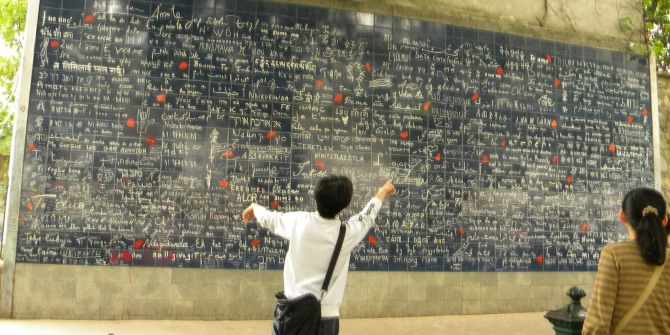Source:
http://blogs.lse.ac.uk/impactofsocialsciences/2016/04/18/writing-for-impact-how-can-we-write-about-our-research-in-a-way-that-leads-to-meaningful-change/
 Academic
Academic
work may have impact in a variety of ways, depending on purpose,
audience and field, but this is most likely to happen when your work
resonates in meaningful ways with people. Ninna Meier encourages
a more systematic investigation of the role of writing in achieving
impact. Impact through writing means getting your readers to understand
and remember your message and leave the reading experience changed. The
challenge is to make what you write resonate with an audience’s
reservoir of experiential knowledge. If the words do not connect to
anything tangible, interest can be quickly lost.
I am currently finishing a three-year impact study and I have so many
things I want to share from this and other projects: in short, I am an
impact geek. But whenever I started writing this text, I stopped; I
wasn’t satisfied with what I wrote, it never came out right, and I
didn’t know quite why. Why is
writing about impact hard, while
researching it or
talking about it
comes much more natural to me? Could it be something in the nature of
the concept or phenomenon itself? Or is it just me? Once I start
reflecting on the impact of my work, my usual academic language does not
suffice. Sure, I can write the academic paper presenting the
theoretical framework, the method and data analysis and share the
results, but the really interesting questions of impact escapes this
kind of writing to some degree. And I think
writing as a way of impacting holds some of the answers.
I first started thinking about this back when I was ‘writing up’ the
results of my PhD and I had what I then thought of as surplus material
in the lots and lots of field notes and my interview material from the
study of clinical managers in different types of bed units. ‘My’
managers were often not involved in the clinical work with patients, but
they were managers of people, who diagnosed, treated, cared for and
comforted very sick people. And although the relational nature of
clinical managerial work made it in to the PhD as an important result, I
was never completely happy with the way I wrote about it. A crucial
link was not unfolded sufficiently explaining the potential effects of
how a certain local context could impact work and vice versa. In short,
what impact a certain place and practice had on the work and people who
performed it and how I managed to convey this in order to impact
research and practice.
One of my units was a stroke unit and I was dissatisfied with the way
I wrote about the connections between this unit as a place, the type of
patients that were there, the rehabilitation and care they needed, the
way work was organized and politically governed, and the kind of
clinical managerial work that was practiced there. The texts always
seemed devoid of the life, the physical bodies, the complexity and pace
of work, the
urgency felt when an alarm rang, or the genuine welcoming atmosphere the place had.
I started experimenting with how to write as to include the messy
world of context, an advice one of my committee members gave me at my
defence. I wrote to let readers experience the impact of
being there,
detailed sensory laden accounts of the sights, smells, noises and
impressions I had experienced. But these kinds of text were not entirely
right either. What is it, then? In my current project, I use drawings, I
experiment with composite characters, and I build stories in which the
small, almost unnoticeable, yet immensely important details can be
included, because I can show them as
possible experiences: ‘this is how it
could happen’, as examples of experiential knowledge for the reader to relate to.
But I still struggle, even with writing this text. It is as if the
words themselves, for writing about this in an academic text, are not
there; as if the vocabulary belongs to real life and seemingly small
lived experiences and not academia. It is the language of
particulars,
of everyday life with patients and colleagues, where impact might mean
you help someone regain the ability to speak or shower. And then again;
although these are important aspects, they cannot stand alone in our
world: for academic work to have impact, we usually aim to reach people
beyond the
particular setting and share the results much more broadly. Impact
through writing means getting your readers to understand and remember
your message and leave the reading experience changed.
Real impact,
the kind we academics dream about, means that other people take your
work/message/results and change something because of this.
And one of the main points arising from my work is that this is most
likely to happen when your work resonates in meaningful ways with
people. This leaves the challenge of making
what you write
resonate with them through how it connects to their reservoir of
experiential knowledge (which you cannot know in advance, only offer the
possibilities for). As
Wikan (2012)
points out, this kind of writing is connected to your methods and the
things you’ve seen, learned and engaged in during your research. For me,
being there in person is an indispensable part of the process and it is
tied to
how you write and which possible connections you offer
your reader to latch on and relate their own experience to. Writing
that is too ‘far’ from life makes it difficult for me to ‘see’ what this
means in practice. Papers can be abstract, philosophical or theoretical
in nature, and remain ‘attached’ to the concept or phenomenon they are
about. But if the words do not connect to anything I can picture and
understand, I quickly lose interest and have a hard time remembering the
paper.
I am not done thinking about and writing about impact in practice,
but it all comes down to this important part of the process: what
happens
after the reader puts down the paper or leaves the
auditorium? Does she use your work in her own research? Does he tell his
colleagues about it over lunch or share it on social media? Will it
become part of the theoretical foundation on which future impact studies
build? Our work may have impact in a variety of ways, depending on
purpose, audience and field, but I would like to encourage a more
systematic investigation of and attention to the role of writing in
achieving this!
Note: This article gives the views of the author, and not the
position of the LSE Impact blog, nor of the London School of Economics.
Please review our Comments Policy if you have any concerns on posting a comment below.
About the Author
Ninna Meier is a postdoctoral fellow at Department
of organization, at Copenhagen Business School. She has researched
organization and management practices in health care work since 2009,
currently exploring what it takes to achieve coherency in patient
pathways. How to impact in practice, specifically the role of writing in
this, is one of her main interests



 Academic
Academic The
The